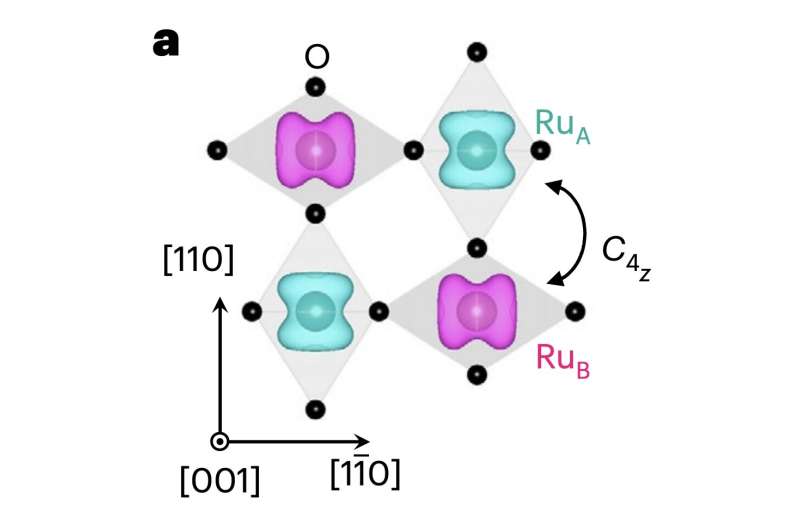November 30, 2022 feature
The observation of an anomalous Hall effect in altermagnetic ruthenium dioxide

The Hall effect is a conduction phenomenon discovered by physicist Edwin Herbert Hall that describes the development of a transverse electric field in solid materials carrying electric current that are placed in a magnetic field perpendicular to this current. In the 1950s, Martin Karplus and Joaquin Mazdak Luttinger showed that an anomalous Hall conductivity could also be observed in ferromagnetic metals with broken time-reversal symmetry.
While ferromagnetic materials have magnetic moments that align parallel to applied magnetic fields, antiferromagnetic materials have antiparallel magnetic moments. Past studies have showed that antiferromagnets do not possess the same magneto-electronic properties as ferromagnets and do not exhibit an anomalous Hall effect. So far, most studies focusing on the anomalous Hall effect were thus conducted on ferromagnets.
Researchers at Beihang University, Johannes Gutenberg Universität Mainz and Huazhong University of Science and Technology have recently observed an anomalous Hall effect in
ruthenium dioxide (RuO2), a material with a classic rutile crystal structure that has recently been found to have an antiparallel magnetic order. Their findings, published in a paper in Nature Electronics, could open interesting possibilities for further research on materials with a so-called compensated antiparallel magnetic order, such as RuO2.
"RuO2 with a compensated antiparallel magnetic order has been predicted to generate an anomalous Hall effect of comparable strength to ferromagnets," Zexin Feng and his colleagues wrote in their paper. "The phenomenon arises from an altermagnetic phase of RuO2 with a characteristic alternating spin polarization in both real-space crystal structure and momentum-space band structure."
In their experiments, Feng and his colleagues used vector magnetometry and magneto-transport measurement techniques. Vector magnetometers are instruments that allow researchers to measure the strength, direction, and other properties of a magnetic field. Magneto-transport measurement systems, on the other hand, can be used to examine the electrical transport properties of materials under a magnetic field.
The researchers applied these two methods to epitaxial RuO2 films with different crystal orientations. The measurements they collected highlighted the occurrence of an anomalous Hall effect.
"We report an anomalous Hall effect in RuO2 with an anomalous Hall conductivity exceeding 1,000 Ω−1 cm−1," Feng and his colleagues explained in their paper. "We combine the vector magnetometry and magneto-transport measurements of epitaxial RuO2 films of different crystallographic orientations. We show that the anomalous Hall effect dominates over an ordinary Hall contribution, and a contribution due to a weak field-induced magnetization."
The findings gathered by this team of researchers show that T symmetry-breaking magneto-electronic effects are not limited to ferromagnets or complex non-collinear magnets, as they can also be found in some materials with an antiparallel magnetic order. In the future, their work could pave the way for other studies probing these effects in other materials with properties matching those of RuO2.
"Our results could lead to the exploration of topological Berry phases and dissipationless quantum transport in crystals of abundant elements and with a compensated antiparallel magnetic order," Feng and his colleagues wrote.
More information: Zexin Feng et al, An anomalous Hall effect in altermagnetic ruthenium dioxide, Nature Electronics (2022). DOI: 10.1038/s41928-022-00866-z
Journal information: Nature Electronics
© 2022 Science X Network



















